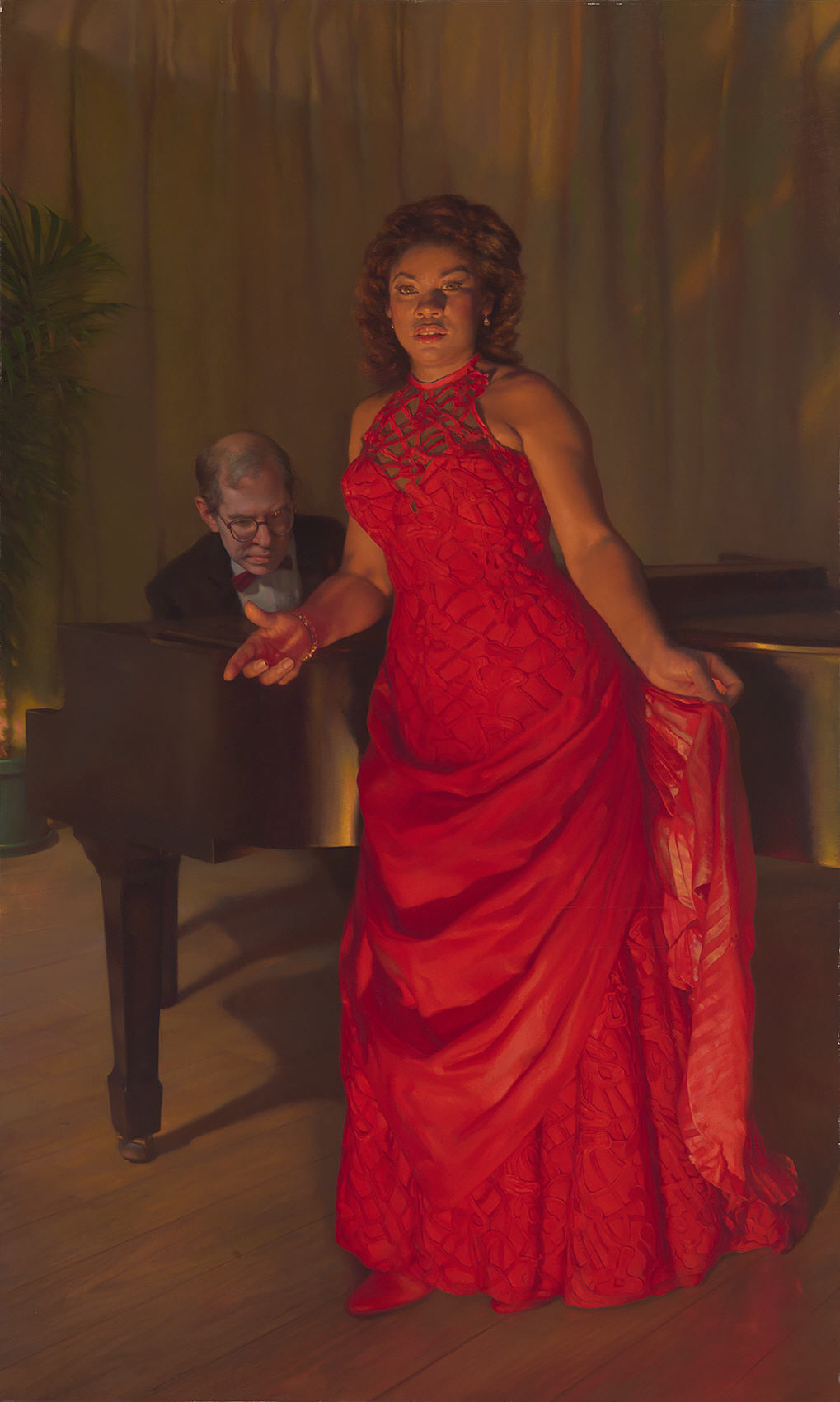A few of my favorite things: Stacey Havard
Smithsonian staff and volunteers work countless hours in the halls of our museums and research centers, in the field, at the Zoo, in our gardens and facilities. We are privileged to spend time with some of the nation’s most cherished treasures as we go about our duties. Sometimes, these unique experiences find a special place in our own personal stories. Amy Kehs introduces Stacey Havard and a few of her favorite things.

An autumn sunrise at the Smithsonian Environmental Research Center in Edgewater, Md.
It is a beautiful day—the sky is that true sky blue color, the air is crisp, and fall is just around the corner. I am on my way to meet with Stacey Havard, biologist at the Smithsonian Environmental Research Center in Edgewater, Md. The narrow, road through the campus winds through fields, the remains of a historic brick mansion, an old tobacco barn and then finally, through the trees I can see the Reed Education Center with glistening water just behind it. The parking lot is filled with buses and you can hear excited children down by the water on the dock. I imagine that most visitors, even most Smithsonian employees, would be surprised that this tranquil shoreline is part of the Smithsonian. Of all the treasures we protect, this 2,650-acre campus of forest, wetlands, marsh and 15 miles of protected shoreline is among the most unique and surprisingly precious gems in our Smithsonian treasure trove. Just 33 miles from downtown Washington, D.C., SERC is headquartered on Chesapeake Bay, the nation’s largest estuary, and serves as a natural laboratory for state-of-the-art ecological research.
Stacey, who has a degree in biology from Elon University, has worked at SERC since 2007. She works on two main projects for SERC’s Marine Invasions Research Laboratory, which is led by Senior Scientist Greg Ruiz. The first is an onsite survey of the shallow-water ‘nearshore’ ecology of the Rhode River. The scientists at SERC have been collecting data on local shrimp populations since 1991 to understand the dynamics between the native grass shrimp species and their fish and crab predators. The study includes three methods of data collection: seining for fish, dip-netting for shrimp, and shrimp tethering. To tether shrimp, Stacey and her colleagues attach an itty-bitty hook onto the shrimp and then see what preys on the shrimp. Stacey, known to the local bait and tackle merchants as the “shrimp lady who asks for those crazy small hooks,” has been leading the study since she joined the Smithsonian. The team also hopes that this project will shed some light on the long-term health of the ecosystem.

Stacey Havard, SERC biologist, pulls a seine net along the shoreline. (Photo by Whitney McClees)
Stacey’s second major project involves surveying North American bays for marine invertebrates that travel from one part of the world to another by hitching a ride on the hulls of commercial ships. This project’s goal is to detect new invasive species and track the movement of existing invaders that have made a home for themselves in a new bay or harbor. Stacey works on these field surveys, including managing and constructing the project’s databases and identifying tiny barnacles.
Stacey’s first Smithsonian favorite is the charismatic fauna that live in or near the SERC wildlife sanctuary. “If you sit on the dock and pause a minute to take in what is around you, it’s amazing what you can see and hear along this shoreline,” she says. Whether it is her favorite little shrimps or fishes, or a snake or caterpillar that might cross her path on the trail to her field site, Stacey thinks she is extremely lucky to share her “office” with critters of all shapes and sizes.

Stacey Havard holds a juvenile Hogchoker, a flatfish commonly found in the shallows of the Rhode River. (Photo by Leorah McGinnis)
Stacey’s second Smithsonian favorite is the painting of Denyce Graves called “The Recital” at the National Portrait Gallery. Born in Washington, D.C., Graves is a world-renowned opera singer. The painting was done by Nelson Shanks in 2000 and depicts Graves in a vibrant red dress. Stacey says, “I love how poised she is. The artist has so perfectly captured that moment right before she sings her first note. The depiction of the light on her is also amazing. Her skin is radiant, and her dress is luminous. When you visit the museum, you come around the corner and there she is. The sheer intensity of color in the portrait takes my breath away. When I play tour guide for family and friends, it is always on my list of things to see.”
Stacey also loves that Graves calls Washington, D.C. her hometown. “I grew up outside of D.C. and I do love that go-go beat! But I also love that great artists from a range of genres got their start right here in the District. Ms. Graves’ brilliant opera career is a perfect example of that, and I’m glad our museums reflect that range in their featured musicians.”

Denyce Graves by Nelson Shanks, oil on canvas, 2000, promised gift of Ian and Annette Cumming (Courtesy National Portrait Gallery)
Stacey admits that her third Smithsonian favorite is a bit hard to explain and might seem like an odd pick but she absolutely loves and appreciates the contemporary architecture of the newer Smithsonian buildings.
“My third Smithsonian favorite is the architecture, specifically the windows, of the more recent Smithsonian buildings such as the National Museum of African American History and Culture, National Museum of the American Indian and the Hirshhorn. “I love the way the different architects have chosen to make statements or curate how museum visitors view the landscape of the National Mall or key Mall buildings. They seem to have carefully designed these views to impact the feelings that the visitor is experiencing as they move through the museum, sometimes watchful or on alert, sometimes welcoming and softening, sometimes isolating.” One example she gives is the intentionally-positioned narrow window overlooking the Washington Monument on the fourth floor of NMAAHC. Another example is the curves and organic design of the windows in the café at NMAI. “Even though I recently moved out of D.C., it still feels like my city. I love how the museums and monuments tell the stories of America. These details in the more contemporary architecture sometimes get overlooked, but I think it can have a strong impact and I try to be aware of it when I’m visiting our museums.”

Smithsonian’s National Museum of African American History and Culture (Photo by Gina Whiteman)
When I asked Stacey what she wants her fellow Smithsonian staff to know about her job and SERC she said, “Please come visit this part of the Smithsonian! It’s truly not that far; when I lived downtown, it only took me 35 minutes to get here. Take a moment to explore, walk the trails, sit down by the water and enjoy the tranquility. If you see a staff member, please don’t hesitate to ask us a question. I think everyone that visits will be pleased to learn that this is part of our Smithsonian campus.”
SERC is open to the public Monday through Saturday from 8:30 a.m. until 4:30 p.m. It is closed on Federal holidays. Visitors are asked to check in at the Reed Education Center before exploring the trails or launching their kayaks. Be on the lookout for SERC’s Open House each spring, too!
Posted: 13 December 2018
-
Categories:
Environmental Research Center , Feature Stories , Portrait Gallery , Science and Nature






I enjoy these staff features because you learn something new about the Smithsonian that you possible never previously knew. I just discovered that SERC was open to the public on weekends, and plan on visiting. It sounds like a wonderful place. Mentions of the Graves portrait, and museum architecture will give me new destinations to visit.